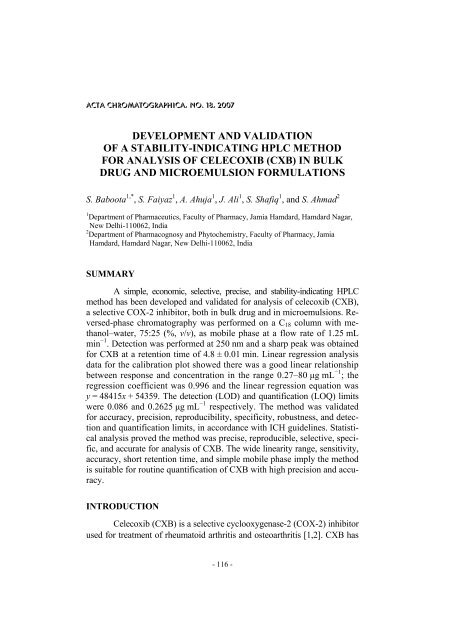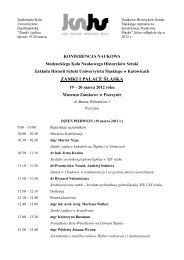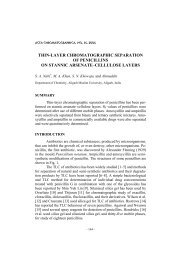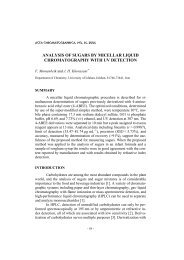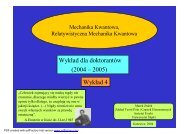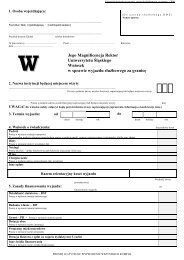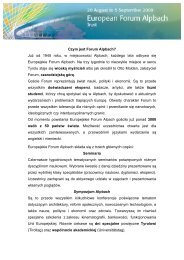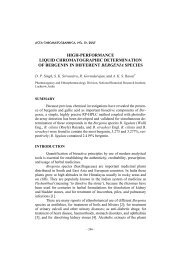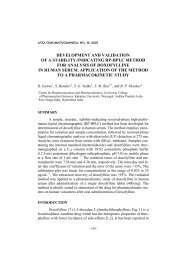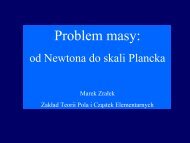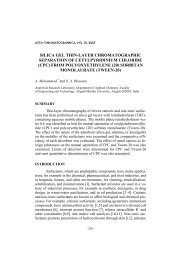Development and validation of stability-indicating HPLC method for ...
Development and validation of stability-indicating HPLC method for ...
Development and validation of stability-indicating HPLC method for ...
Create successful ePaper yourself
Turn your PDF publications into a flip-book with our unique Google optimized e-Paper software.
ACTA CHROMATOGRAPHICA, NO. 18, 2007<br />
DEVELOPMENT AND VALIDATION<br />
OF A STABILITY-INDICATING <strong>HPLC</strong> METHOD<br />
FOR ANALYSIS OF CELECOXIB (CXB) IN BULK<br />
DRUG AND MICROEMULSION FORMULATIONS<br />
S. Baboota 1,* , S. Faiyaz 1 , A. Ahuja 1 , J. Ali 1 , S. Shafiq 1 , <strong>and</strong> S. Ahmad 2<br />
1 Department <strong>of</strong> Pharmaceutics, Faculty <strong>of</strong> Pharmacy, Jamia Hamdard, Hamdard Nagar,<br />
New Delhi-110062, India<br />
2 Department <strong>of</strong> Pharmacognosy <strong>and</strong> Phytochemistry, Faculty <strong>of</strong> Pharmacy, Jamia<br />
Hamdard, Hamdard Nagar, New Delhi-110062, India<br />
SUMMARY<br />
A simple, economic, selective, precise, <strong>and</strong> <strong>stability</strong>-<strong>indicating</strong> <strong>HPLC</strong><br />
<strong>method</strong> has been developed <strong>and</strong> validated <strong>for</strong> analysis <strong>of</strong> celecoxib (CXB),<br />
a selective COX-2 inhibitor, both in bulk drug <strong>and</strong> in microemulsions. Reversed-phase<br />
chromatography was per<strong>for</strong>med on a C 18 column with methanol–water,<br />
75:25 (%, v/v), as mobile phase at a flow rate <strong>of</strong> 1.25 mL<br />
min −1 . Detection was per<strong>for</strong>med at 250 nm <strong>and</strong> a sharp peak was obtained<br />
<strong>for</strong> CXB at a retention time <strong>of</strong> 4.8 ± 0.01 min. Linear regression analysis<br />
data <strong>for</strong> the calibration plot showed there was a good linear relationship<br />
between response <strong>and</strong> concentration in the range 0.27–80 µg mL −1 ; the<br />
regression coefficient was 0.996 <strong>and</strong> the linear regression equation was<br />
y = 48415x + 54359. The detection (LOD) <strong>and</strong> quantification (LOQ) limits<br />
were 0.086 <strong>and</strong> 0.2625 µg mL −1 respectively. The <strong>method</strong> was validated<br />
<strong>for</strong> accuracy, precision, reproducibility, specificity, robustness, <strong>and</strong> detection<br />
<strong>and</strong> quantification limits, in accordance with ICH guidelines. Statistical<br />
analysis proved the <strong>method</strong> was precise, reproducible, selective, specific,<br />
<strong>and</strong> accurate <strong>for</strong> analysis <strong>of</strong> CXB. The wide linearity range, sensitivity,<br />
accuracy, short retention time, <strong>and</strong> simple mobile phase imply the <strong>method</strong><br />
is suitable <strong>for</strong> routine quantification <strong>of</strong> CXB with high precision <strong>and</strong> accuracy.<br />
INTRODUCTION<br />
Celecoxib (CXB) is a selective cyclooxygenase-2 (COX-2) inhibitor<br />
used <strong>for</strong> treatment <strong>of</strong> rheumatoid arthritis <strong>and</strong> osteoarthritis [1,2]. CXB has<br />
- 116 -
analgesic, antipyretic, <strong>and</strong> anti-inflammatory activity as a result <strong>of</strong> selective<br />
inhibition <strong>of</strong> the enzyme COX-2 <strong>and</strong> does not inhibit platelet aggregation<br />
[3]. In contrast with other non-steroidal anti-inflammatory drugs<br />
(NSAIDs) it has neither acute nor chronic gastrointestinal toxicity [1–4].<br />
CXB is also used <strong>for</strong> treatment <strong>of</strong> colon cancer [5], ultraviolet (UV) lightinduced<br />
skin cancer [6], <strong>and</strong> breast cancer [7].<br />
A thorough literature survey has revealed that a limited number <strong>of</strong><br />
spectrophotometric, fluorimetric, voltammetric, electrophoretic, <strong>and</strong> chromatographic<br />
<strong>method</strong>s have been reported <strong>for</strong> analysis <strong>of</strong> CXB [8]. An ultraviolet<br />
(UV) spectrophotometric <strong>method</strong> based on absorption at 251 nm<br />
was used <strong>for</strong> assay <strong>of</strong> CXB in bulk drugs <strong>and</strong> capsules [9]. The <strong>method</strong><br />
was unsuitable <strong>for</strong> assay <strong>of</strong> CXB in microemulsion <strong>for</strong>mulations, because<br />
oil peaks interfered with the CXB peak. It was, there<strong>for</strong>e, thought worthwhile<br />
to develop a <strong>stability</strong>-<strong>indicating</strong> chromatographic <strong>method</strong> <strong>for</strong> assay<br />
<strong>of</strong> CXB in bulk drugs <strong>and</strong> pharmaceutical dosage <strong>for</strong>ms. Chromatographic<br />
<strong>method</strong>s using acetonitrile <strong>and</strong> buffer as mobile phase have been reported<br />
<strong>for</strong> assay <strong>of</strong> CXB in biological fluids [10–16], bulk drugs [17–20], <strong>and</strong><br />
pharmaceutical dosage <strong>for</strong>ms [21] but only two <strong>method</strong>s are available <strong>for</strong><br />
analysis <strong>of</strong> CXB in pharmaceutical dosage <strong>for</strong>ms which use methanol–water<br />
(85:15) as mobile phase [22,23]. In one <strong>of</strong> these <strong>method</strong>s a mass spectrophotometer<br />
was used as detector [22].<br />
The principal objective <strong>of</strong> this study was, there<strong>for</strong>e, to develop a<br />
new, simple, economical, selective, precise, reproducible, <strong>and</strong> <strong>stability</strong><strong>indicating</strong><br />
high-per<strong>for</strong>mance liquid chromatographic (<strong>HPLC</strong>) <strong>method</strong> with<br />
a wide linear range <strong>and</strong> good sensitivity <strong>for</strong> assay <strong>of</strong> CXB in the bulk drug<br />
<strong>and</strong> in microemulsion <strong>for</strong>mulations using UV detection. In the <strong>method</strong><br />
proposed the mobile phase was used directly <strong>for</strong> dilution <strong>of</strong> the <strong>for</strong>mulation<br />
after filtration, <strong>and</strong> then further used <strong>for</strong> analysis. Direct use <strong>of</strong> the<br />
mobile phase as diluent <strong>for</strong> <strong>for</strong>mulations in quantitative analysis minimizes<br />
errors that occur during tedious extraction procedures. The <strong>method</strong> was<br />
validated in accordance with International Conference on Harmonization<br />
(ICH) guidelines [24].<br />
EXPERIMENTAL<br />
Chemicals<br />
CXB was obtained as a gift from Ranbaxy Research Laboratory,<br />
Gurgaon, India. <strong>HPLC</strong>-grade methanol was purchased from Merck, India.<br />
- 117 -
High-purity water was prepared using Millipore purification system. Other<br />
chemicals <strong>and</strong> reagents were <strong>of</strong> AR grade.<br />
Chromatography<br />
Chromatography was per<strong>for</strong>med, under ambient conditions, with<br />
Shimadzu <strong>HPLC</strong> equipment comprising quaternary LC-10A VP pumps, a<br />
variable-wavelength programmable UV–visible detector, SPD-10AVP column<br />
oven, <strong>and</strong> a SCL 10AVP system controller. Samples (20 µL) were<br />
injected by means <strong>of</strong> a Rheodyne injector fitted with a 20-µL loop. The instrumentation<br />
was controlled by use <strong>of</strong> Class-VP 5.032 s<strong>of</strong>tware. Compounds<br />
were separated on a 25 cm × 4.6 mm i.d., 5-µm particle, 516 C 18 DB reversed-phase<br />
column (Supelco). The mobile phase was methanol–water, 75:25,<br />
at a flow rate <strong>of</strong> 1.25 mL min −1 . The eluate was monitored at 250 nm.<br />
Method <strong>Development</strong><br />
A variety <strong>of</strong> mobile phases were investigated in the development<br />
<strong>of</strong> an <strong>HPLC</strong> <strong>method</strong> suitable <strong>for</strong> analysis <strong>of</strong> CXB in the bulk drug <strong>and</strong> in<br />
microemulsions. These included methanol–water, 75:25 (% v/v), acetonitrile–water,<br />
75:25, methanol–water, 50:50, methanol–water, 95:5, methanol–phosphate<br />
buffer (pH 3.5–6.5), 80:20, <strong>and</strong> acetonitrile–phosphate buffer<br />
(pH 3.5–6.5), 80:20. The suitability <strong>of</strong> the mobile phase was decided<br />
on the basis <strong>of</strong> the sensitivity <strong>of</strong> the assay, suitability <strong>for</strong> <strong>stability</strong> studies,<br />
time required <strong>for</strong> the analysis, ease <strong>of</strong> preparation, <strong>and</strong> use <strong>of</strong> readily available<br />
cost-effective solvents. The same solvent mixture was used <strong>for</strong> extraction<br />
<strong>of</strong> the drug from the <strong>for</strong>mulation containing excipients.<br />
Method Validation<br />
Linearity<br />
A stock solution <strong>of</strong> CXB (100 µg mL −1 ) was prepared by dissolving<br />
50 mg drug in 100 mL mobile phase then transferring 2 mL <strong>of</strong> this<br />
solution to a 10-mL volumetric flask <strong>and</strong> diluting to volume. Solutions <strong>of</strong><br />
different concentration (0.27–80 µg mL −1 ) <strong>for</strong> construction <strong>of</strong> calibration<br />
plots were prepared from this stock solution. The mobile phase was filtered<br />
through a 0.45-µm membrane filter <strong>and</strong> delivered at 1.25 mL min −1 <strong>for</strong><br />
column equilibration; the baseline was monitored continuously during this<br />
process. The detection wavelength was 250 nm. The prepared dilutions<br />
were injected in series, peak area was calculated <strong>for</strong> each dilution, <strong>and</strong><br />
concentration was plotted against peak area.<br />
- 118 -
Accuracy, as Recovery<br />
Accuracy was determined by the st<strong>and</strong>ard addition <strong>method</strong>. Previously<br />
analyzed samples <strong>of</strong> CXB (8 µg mL −1 ) were spiked with 0, 50, 100,<br />
<strong>and</strong> 150% extra CXB st<strong>and</strong>ard <strong>and</strong> the mixtures were analyzed by the proposed<br />
<strong>method</strong>. The experiment was per<strong>for</strong>med in triplicate. Recovery (%),<br />
RSD (%), bias (%), <strong>and</strong> st<strong>and</strong>ard error <strong>of</strong> mean (SEM) were calculated <strong>for</strong><br />
each concentration.<br />
Precision<br />
Precision was determined as both repeatability <strong>and</strong> intermediate precision,<br />
in accordance with ICH recommendations. Repeatability <strong>of</strong> sample<br />
injection was determined as intra-day variation <strong>and</strong> intermediate precision<br />
was determined by measurement <strong>of</strong> inter-day variation. For both intra-day<br />
<strong>and</strong> inter-day variation, solutions <strong>of</strong> CXB at four different concentrations<br />
(4, 8, 12, <strong>and</strong> 16 µg mL −1 ) were determined in triplicate.<br />
Reproducibility<br />
The reproducibility <strong>of</strong> the <strong>method</strong> was checked by determining precision<br />
on a different instrument, analysis being per<strong>for</strong>med by another person<br />
in different laboratory. For both intra-day <strong>and</strong> inter-day variation, solutions<br />
<strong>of</strong> CXB at four different concentrations (4, 8, 12, <strong>and</strong> 16 µg mL −1 )<br />
were determined in triplicate.<br />
Specificity<br />
The specificity <strong>of</strong> the <strong>method</strong> was determined by exposing a solution<br />
(8 µg mL −1 ) <strong>of</strong> the sample to acidic (0.1 M HCl), basic (0.1 M NaOH),<br />
<strong>and</strong> oxidising (3% H 2 O 2 ) stress conditions. The resulting solutions were<br />
then analyzed <strong>and</strong> the analyte peak was evaluated both <strong>for</strong> peak purity <strong>and</strong><br />
<strong>for</strong> resolution from the nearest eluting peak.<br />
Detection (LOD) <strong>and</strong> Quantification (LOQ) Limits<br />
LOD <strong>and</strong> LOQ were determined by the st<strong>and</strong>ard deviation (S y/x )<br />
<strong>method</strong>. Blank samples were injected in triplicate <strong>and</strong> the peak area <strong>of</strong> this<br />
blank was calculated. LOD <strong>and</strong> LOQ were determined from the slope, S,<br />
<strong>of</strong> the calibration plot <strong>and</strong> the st<strong>and</strong>ard deviation <strong>of</strong> the response <strong>for</strong> the<br />
blank sample, S y/x , by use <strong>of</strong> the <strong>for</strong>mulae LOD = 3.3 × S y/x /S <strong>and</strong> LOQ =<br />
10 × S y/x /S.<br />
- 119 -
Robustness<br />
The robustness <strong>of</strong> the <strong>method</strong> was determined to assess the effect<br />
<strong>of</strong> small but deliberate variation <strong>of</strong> the chromatographic conditions on the<br />
determination <strong>of</strong> CXB. Robustness was determined by changing the mobile<br />
phase flow rate to 1 <strong>and</strong> 1.5 mL min −1 <strong>and</strong> the concentration <strong>of</strong> methanol<br />
in the mobile phase to 73 <strong>and</strong> 77%.<br />
Stability<br />
The <strong>stability</strong> <strong>of</strong> the drug in solution during analysis was determined<br />
by repeated analysis <strong>of</strong> samples during the course <strong>of</strong> experimentation on<br />
the same day <strong>and</strong> also after storage <strong>of</strong> the drug solution <strong>for</strong> 48 h under laboratory<br />
bench conditions (32 ± 1°C) <strong>and</strong> under refrigeration (8 ± 0.5°C).<br />
Analysis <strong>of</strong> CXB in Microemulsion<br />
To determine the CXB content <strong>of</strong> the microemulsion (label claim<br />
20 mg mL −1 ), 1 mL microemulsion was suitably diluted with mobile phase<br />
to furnish 100 mL stock solution. This solution was sonicated <strong>for</strong> 10 min<br />
then analyzed <strong>for</strong> drug content. The analysis was repeated in triplicate.<br />
The possibility <strong>of</strong> interference <strong>of</strong> excipients with the analysis was studied.<br />
RESULTS AND DISCUSSION<br />
Method <strong>Development</strong><br />
The <strong>HPLC</strong> procedure was optimized with a view to developing a<br />
<strong>method</strong> <strong>for</strong> <strong>stability</strong>-<strong>indicating</strong> assay. No internal st<strong>and</strong>ard was used because<br />
no extraction or separation step was involved. Of several solvents <strong>and</strong><br />
solvent mixtures investigated methanol–water 75:25 (%, v/v) was found to<br />
Fig. 1<br />
<strong>HPLC</strong> chromatogram obtained from celecoxib in methanol–water 75:25 (% v/v), t R 4.8 min<br />
- 120 -
furnish sharp, well-defined peaks with very good symmetry (1.25) <strong>and</strong> low<br />
t R (4.8 min) (Fig. 1). With acetonitrile–water 75:25 as mobile phase t R was<br />
5.9 min (Fig. 2) <strong>and</strong> peak shape <strong>and</strong> sensitivity were poor. Acetonitrile<br />
was also more expensive than methanol. Methanol–water 95:05 (Fig. 3)<br />
<strong>and</strong> methanol–water 50:50 (Fig. 4) did not furnish sharp, well-defined<br />
peaks <strong>and</strong> other mobile phases tried either resulted in much lower sensitivity<br />
or did not give well defined peaks in a short time, <strong>and</strong> so were not<br />
considered.<br />
Fig. 2<br />
<strong>HPLC</strong> chromatogram obtained from celecoxib in acetonitrile–water 75:25 (% v/v), t R 5.9 min<br />
0.010<br />
0.010<br />
0.008<br />
0.008<br />
0.006<br />
0.006<br />
0.004<br />
0.004<br />
Volts<br />
0.002<br />
0.002<br />
Volts<br />
0.000<br />
13.883<br />
0.000<br />
-0.002<br />
10.358<br />
18.817<br />
-0.002<br />
-0.004<br />
-0.004<br />
0 2 4 6 8 10 12 14 16 18 20<br />
Minutes<br />
Fig. 3<br />
<strong>HPLC</strong> chromatogram obtained from celecoxib in methanol–water 50:50 (% v/v)<br />
- 121 -
0.150<br />
2.658<br />
0.150<br />
0.125<br />
2.308<br />
2.500<br />
0.125<br />
0.100<br />
3.833<br />
0.100<br />
Volts<br />
0.075<br />
0.075<br />
Volts<br />
0.050<br />
6.050<br />
0.050<br />
0.025<br />
0.025<br />
0.383<br />
2.875<br />
0.000<br />
0.000<br />
Fig. 4<br />
0 1 2 3 4 5 6 7 8 9 10<br />
<strong>HPLC</strong> chromatogram obtained from celecoxib in methanol–water 95:5 (% v/v)<br />
The final decision on mobile phase composition <strong>and</strong> flow rate was<br />
made on the basis <strong>of</strong> peak shape (peak area, asymmetry, tailing factor),<br />
baseline drift, time required <strong>for</strong> analysis, <strong>and</strong> cost <strong>of</strong> solvent, <strong>and</strong> methanol–water<br />
75:25 (%, v/v) was selected as the optimum mobile phase. Under<br />
these conditions the retention time <strong>and</strong> asymmetry factor were 4.8 ± 0.01<br />
min <strong>and</strong> 1.25 ± 0.03, respectively.<br />
Validation <strong>of</strong> the Method<br />
Linearity<br />
The calibration plot <strong>of</strong> peak area against concentration was linear<br />
in the range investigated (0.27–80 µg mL −1 ). Calibration data, with their<br />
relative st<strong>and</strong>ard deviations, % RSD, st<strong>and</strong>ard error, <strong>and</strong> 95% confidence<br />
intervals are listed in Table I.<br />
The low values <strong>of</strong> RSD <strong>and</strong> st<strong>and</strong>ard error show the <strong>method</strong> is precise.<br />
Statistical calculations were per<strong>for</strong>med at the 5% level <strong>of</strong> significance.<br />
The linear regression data <strong>for</strong> the calibration plot are indicative <strong>of</strong> a<br />
good linear relationship between peak area <strong>and</strong> concentration over a wide<br />
range. The linear regression equation was y = 48415x + 54359 <strong>and</strong> the regression<br />
coefficient was 0.996. Other linear regression data are given in<br />
Table II. This per<strong>for</strong>mance was superior to that <strong>of</strong> other currently used <strong>method</strong>s<br />
[9,23]. The correlation coefficient was indicative <strong>of</strong> high significance.<br />
The low values <strong>of</strong> the st<strong>and</strong>ard deviation, the st<strong>and</strong>ard error <strong>of</strong> slope,<br />
<strong>and</strong> the intercept <strong>of</strong> the ordinate showed the calibration plot did not devia-<br />
Minutes<br />
- 122 -
Table I<br />
Calibration data <strong>for</strong> CXB with methanol–water 75:25 (%, v/v) as mobile phase<br />
Concn Mean area ± SD RSD St<strong>and</strong>ard 95% Confidence interval<br />
(µg mL −1 ) (n = 3) (%) error Lower value Upper value<br />
00.27 67431 ± 256.33 0.38 147.80 66795 68067<br />
00.5 23664 ± 360.64 1.50 208.22 22511 24303<br />
01.0 46310 ± 225.01 0.48 129.91 45674 46792<br />
02.0 104611 ± 846.56 0.80 488.76 102412 106618<br />
04.0 203388 ± 2193.62 1.07 1266.50 198980 209882<br />
06.0 297949 ± 4080.26 1.36 2343.10 284353 304517<br />
08.0 409408 ± 5668.98 1.38 3273.00 391417 419585<br />
10 502372 ± 3518.43 0.70 2031.40 493416 510898<br />
12 697107 ± 5686.56 0.82 3283.10 679718 707973<br />
14 781115 ± 2813.18 0.36 1625.20 775147 789133<br />
16 927884 ± 4915.03 0.52 2828.80 913446 937790<br />
20 1156918 ± 3640.25 0.31 2101.70 1145048 1163135<br />
40 2071982 ± 33014.52 1.59 19061.00 2000290 2164329<br />
60 2930455 ± 51328.06 1.75 29634.00 2815834 3070866<br />
80 3875772 ± 60963.03 1.57 35197.00 3688923 3991828<br />
Table II<br />
Linear regression data <strong>for</strong> the calibration plot (n = 3)<br />
Linearity range (µg mL −1 ) 0.27–80<br />
Regression equation y = 48415x + 54359<br />
Correlation coefficient 0.996<br />
Slope ± SD 48415 ± 102.321<br />
Intercept ± SD 54359 ± 81.231<br />
Slope without intercept ± SD 49716 ± 120.974<br />
St<strong>and</strong>ard error <strong>of</strong> slope 59.076<br />
St<strong>and</strong>ard error <strong>of</strong> intercept 46.076<br />
95% Confidence interval <strong>of</strong> slope 48669.204–48160.795<br />
95% Confidence interval <strong>of</strong> intercept 54557.265–54160.735<br />
Bias <strong>of</strong> intercept −0.0261<br />
te from linearity. There were no significant differences between the slopes<br />
<strong>of</strong> st<strong>and</strong>ard curves constructed on different days.<br />
Accuracy, as Recovery<br />
The recovery <strong>of</strong> the <strong>method</strong>, determined by spiking a previously<br />
analyzed test solution with additional drug st<strong>and</strong>ard solution, was 99.84–<br />
- 123 -
101.01%. The values <strong>of</strong> recovery (%), RSD (%), percentage bias, <strong>and</strong> SEM<br />
listed in Table III indicate the <strong>method</strong> is accurate.<br />
Table III<br />
Accuracy <strong>of</strong> the <strong>method</strong> (n = 3)<br />
Amount (%)<br />
<strong>of</strong> drug added<br />
to analyte<br />
Precision<br />
Theoretical<br />
content<br />
(µg mL −1 )<br />
Concn found<br />
(µg mL −1 ) ± SD<br />
Recovery<br />
(%)<br />
RSD<br />
(%)<br />
Bias<br />
(%)<br />
SEM<br />
0 8 8.02 ± 0.128 100.29 1.59 +0.299 0.074<br />
50 12 12.08 ± 0.125 100.69 1.03 +0.695 0.072<br />
100 16 16.16 ± 0.080 101.01 0.49 +1.010 0.046<br />
150 20 19.97 ± 0.194 99.84 0.97 −0.162 0.112<br />
Precision was considered at two levels, i.e. repeatability <strong>and</strong> intermediate<br />
precision, in accordance with ICH recommendations. Repeatability<br />
<strong>of</strong> sample injection was determined as intra-day variation whereas intermediate<br />
precision was determined by measuring inter-day variation <strong>for</strong><br />
triplicate determination <strong>of</strong> CXB at four different concentrations (4, 8, 12, <strong>and</strong><br />
16 µg mL −1 ). Results from determination <strong>of</strong> repeatability <strong>and</strong> intermediate<br />
precision, expressed as RSD (%), are listed in Table IV. The low values <strong>of</strong><br />
RSD indicate the repeatability <strong>of</strong> the <strong>method</strong>.<br />
Table IV<br />
Precision <strong>of</strong> the <strong>method</strong><br />
Repeatability (intra-day precision) Intermediate precision (inter-day)<br />
Concn<br />
(µg mL −1 ) Mean area ± SD<br />
RSD Mean area ± SD<br />
RSD<br />
SEM<br />
SEM<br />
(n = 3)<br />
(%) (n = 3)<br />
(%)<br />
4 247244.7 ± 3850.75 2223.30 1.55 243890.0 ± 4602.40 2657.27 1.88<br />
8 448173.0 ± 2254.59 1301.93 0.50 445154.7 ± 5017.66 2897.03 1.12<br />
12 643443.7 ± 2159.26 1246.68 0.33 640151.7 ± 4513.91 2606.18 0.70<br />
16 839226.3 ± 1104.47 637.68 0.13 841651.0 ± 4093.55 2363.48 0.48<br />
Reproducibility<br />
Reproducibility was checked by measuring the precision <strong>of</strong> the<br />
<strong>method</strong> in another laboratory on a different instrument with analysis per<strong>for</strong>med<br />
by another person. Both intra-day <strong>and</strong> inter-day precision were de-<br />
- 124 -
termined. There were no significant differences between RSD (%) values<br />
<strong>for</strong> intra-day <strong>and</strong> inter-day precision, which indicates the <strong>method</strong> is reproducible.<br />
The results from determination <strong>of</strong> reproducibility are listed in Table<br />
V.<br />
Table V<br />
Reproducibility <strong>of</strong> the <strong>method</strong><br />
Repeatability (intra-day precision) Intermediate precision (inter-day)<br />
Concn<br />
(µg mL −1 ) Mean area ± SD<br />
RSD Mean area ± SD<br />
RSD<br />
SEM<br />
SEM<br />
(n = 3)<br />
(%) (n = 3)<br />
(%)<br />
4 246687.3 ± 4265.25 2462.61 1.72 247460.0 ± 4563.00 2634.57 1.84<br />
8 445767.0 ± 5333.44 3079.35 1.19 450904.7 ± 4771.50 2754.91 1.05<br />
12 645493.3 ± 7456.00 4304.88 1.15 644604.7 ± 10616.20 6129.45 1.64<br />
16 834830.7 ± 9681.10 5589.55 1.16 843762.0 ± 11059.60 6384.29 1.31<br />
Specificity<br />
The specificity <strong>of</strong> the <strong>method</strong> was determined by exposing a<br />
solution <strong>of</strong> CXB to stress conditions, i.e. 0.1 M HCl, 0.1 M NaOH, <strong>and</strong> 3%<br />
H 2 O 2 . There was no degradation <strong>of</strong> CXB in the presence <strong>of</strong> 0.1 M HCl or<br />
0.1 M NaOH <strong>and</strong> no significant change in peak area <strong>and</strong> retention time <strong>of</strong><br />
CXB. In the presence <strong>of</strong> 3% H 2 O 2 it was found there was a substantial<br />
change in the peak area <strong>of</strong> CXB, but not in the retention time. The results<br />
from these tests are listed in Table VI <strong>and</strong> a chromatogram obtained from<br />
Table VI<br />
Results from <strong>for</strong>ced degradation <strong>of</strong> CXB solution. (The concentration <strong>of</strong> the solution analysed<br />
was 8 µg mL −1 )<br />
Stress<br />
conditions<br />
Mean area ± SD<br />
(n = 3)<br />
SEM<br />
Number <strong>of</strong><br />
degradation<br />
products (t R )<br />
CXB<br />
remaining<br />
(µg mL −1 )<br />
Amount<br />
recovered<br />
(%)<br />
0.1 M HCl 444281.3 ± 3959.11 2285.86 – 8.05 100.67<br />
0.1 M NaOH 440881.0 ± 1152.51 665.42 – 7.98 99.79<br />
3% H 2 O 2 356290.7 ± 4015.58 2318.46 1 (6.2 ± 0.03) 6.23 77.95<br />
CXB after treatment with 3% H 2 O 2 is shown in Fig. 5. A degradation<br />
product (peak 2 in Fig. 5) eluted with a retention time <strong>of</strong> 6.2 ± 0.03 min.<br />
The UV spectra <strong>of</strong> pure CXB (Fig. 6) <strong>and</strong> undegraded CXB (peak 1, t R<br />
4.8 min in Fig. 5) were compared <strong>and</strong> found to be similar with regard to<br />
- 125 -
λ max <strong>and</strong> appearance. This indicated the specificity <strong>of</strong> the <strong>method</strong>. The results<br />
from stress testing, including separation <strong>of</strong> the degradation product<br />
<strong>and</strong> quantification <strong>of</strong> CXB after exposure to stress conditions show the <strong>method</strong><br />
is <strong>stability</strong>-<strong>indicating</strong>.<br />
0.04<br />
Detector A (250nm)<br />
celecoxib<br />
cxb-spe-h2o2-8mcg-01021<br />
Retention Time<br />
Volts<br />
0.02<br />
6.192<br />
0.00<br />
4.800<br />
Fig. 5<br />
0 2 4 6 8<br />
Minutes<br />
<strong>HPLC</strong> chromatogram obtained from celecoxib in methanol–water 75:25 (% v/v) in the<br />
presence <strong>of</strong> 3% H 2 O 2 (peak 1, t R 4.8 min; peak 2, t R 6.2 min)<br />
Fig. 6<br />
UV spectrum <strong>of</strong> celecoxib in methanol–water 75:25 (% v/v)<br />
Detection (LOD) <strong>and</strong> Quantification (LOQ) limits<br />
The LOD <strong>and</strong> LOQ <strong>of</strong> the <strong>method</strong>, determined by the st<strong>and</strong>ard deviation<br />
<strong>method</strong>, as described above, were 0.086 <strong>and</strong> 0.263 µg mL −1 , respectively,<br />
which indicated the <strong>method</strong> can be used <strong>for</strong> detection <strong>and</strong> quantification<br />
<strong>of</strong> CXB over a very wide range <strong>of</strong> concentrations.<br />
- 126 -
Robustness<br />
There was no significant change in the retention time <strong>of</strong> CXB when<br />
the composition <strong>and</strong> flow rate <strong>of</strong> the mobile phase were changed. The low<br />
values <strong>of</strong> the RSD, shown in Tables VII <strong>and</strong> VIII, indicated the robustness<br />
<strong>of</strong> the <strong>method</strong>.<br />
Table VII<br />
Results from testing <strong>of</strong> the robustness <strong>of</strong> the <strong>method</strong> by changing the composition <strong>of</strong> the<br />
mobile phase. (The concentration <strong>of</strong> the solution analysed was 8 µg mL −1 )<br />
Mobile phase composition<br />
(methanol–water)<br />
Original Used Level<br />
75:25<br />
Mean area ± SD<br />
(n = 3)<br />
SEM<br />
Mean t R ± SD<br />
(min)<br />
% Bias<br />
in t R<br />
%RSD<br />
73:27 −2 439032.0 ± 6838.54 3948.35 4.739 ± 0.03 −2.06 1.55<br />
75:25 0 445551.3 ± 2876.37 1660.72 4.810 ± 0.01 0 0.64<br />
77:23 +2 430350.3 ± 7057.6 4074.83 4.623 ± 0.04 −4.54 1.63<br />
Table VIII<br />
Results from testing <strong>of</strong> the robustness <strong>of</strong> the <strong>method</strong> by changing the mobile phase flow<br />
rate. (The concentration <strong>of</strong> the solution analysed was 8 µg mL −1 )<br />
Flow rate (mL min −1 ) Mean area ± SD<br />
SEM<br />
Mean t R ± SD % Bias<br />
Original Used Level (n = 3)<br />
(min) in t R<br />
%RSD<br />
1.0 −0.25 441758.3 ± 3607.45 2082.82 4.764 ± 0.03 −1.65 0.81<br />
1.25 1.25 –0 446513.3 ± 2077.46 1199.46 4.812 ± 0.01 0 0.46<br />
1.5 +0.25 433683.7 ± 2771.26 1600.03 4.721 ± 0.03 −2.47 0.63<br />
Stability<br />
The drug was stable when stored <strong>for</strong> 48 h at laboratory temperature<br />
(32 ± 1°C) <strong>and</strong> under refrigeration (8 ± 0.5°C) in methanol–water 75:25<br />
(% v/v).<br />
Analysis <strong>of</strong> CXB in a Microemulsion Formulation<br />
A single peak was observed at the retention time <strong>of</strong> CXB when the<br />
solution <strong>of</strong> the microemulsion <strong>for</strong>mulation was chromatographed. There<br />
was no interaction between CXB <strong>and</strong> excipients present in the microemulsion.<br />
The CXB content was found to be 99.46% <strong>and</strong> the RSD was 0.94%.<br />
It may, there<strong>for</strong>e, be inferred that degradation <strong>of</strong> CXB in the microemul-<br />
- 127 -
sion <strong>for</strong>mulation had not occurred. The low RSD indicated the suitability<br />
<strong>of</strong> this <strong>method</strong> <strong>for</strong> routine analysis <strong>of</strong> CXB in pharmaceutical dosage <strong>for</strong>ms.<br />
CONCLUSIONS<br />
This <strong>HPLC</strong> <strong>method</strong> is accurate, precise, reproducible, specific, <strong>and</strong><br />
<strong>stability</strong>-<strong>indicating</strong>. The <strong>method</strong> has been found to be better than previously<br />
reported <strong>method</strong>s, because <strong>of</strong> its wide range <strong>of</strong> linearity, use <strong>of</strong> an economical<br />
<strong>and</strong> readily available mobile phase, UV detection, lack <strong>of</strong> extraction<br />
procedures, low t R , no internal st<strong>and</strong>ard, <strong>and</strong> use <strong>of</strong> the same mobile phase<br />
<strong>for</strong> washing <strong>of</strong> the column. All these factors make this <strong>method</strong> suitable <strong>for</strong><br />
quantification <strong>of</strong> CXB in bulk drugs <strong>and</strong> in pharmaceutical dosage <strong>for</strong>ms.<br />
It can there<strong>for</strong>e be concluded that use <strong>of</strong> the <strong>method</strong> can save much time<br />
<strong>and</strong> money <strong>and</strong> it can be used in small laboratories with very high accuracy<br />
<strong>and</strong> a wide linear range. The <strong>method</strong> can be successfully used <strong>for</strong><br />
routine analysis <strong>of</strong> CXB in bulk drug <strong>and</strong> in pharmaceutical dosage <strong>for</strong>ms<br />
without interference. Study <strong>of</strong> the effects <strong>of</strong> exhaustive stress conditions,<br />
<strong>and</strong> separation <strong>and</strong> identification <strong>of</strong> the degradation products, is in progress<br />
in our laboratory.<br />
ACKNOWLEDGEMENTS<br />
The authors are thankful to Ranbaxy Research Laboratory, Gurgaon,<br />
India, <strong>for</strong> providing the sample <strong>of</strong> Celecoxib as a gift. The authors are also<br />
grateful to the University Grants Commission <strong>for</strong> providing a Research<br />
Award to Dr Sanjula Baboota.<br />
REFERENCES<br />
[1] J. Fort, Am. J. Orthop., 28, 13 (1999)<br />
[2] A. Gaurl, A.M. Martel, <strong>and</strong> J. Castner, Drugs Future, 22, 711 (1997)<br />
[3] G.S. Gies, Sc<strong>and</strong>. J. Rheumatol., 109, 31 (1999)<br />
[4] M.M. Goldberg, Clin. Ther., 21, 1497 (1999)<br />
[5] T. Kawamori, C.V. Rao, K. Seibert, <strong>and</strong> B.S. Reddy, Cancer Res.,<br />
58, 409 (1998)<br />
[6] S.M. Fisher, H.H. Lo, G.B. Gordon, K. Seibert, G. Kell<strong>of</strong>,<br />
R.A. Lubet, <strong>and</strong> C.J. Conti, Mol. Carcinog., 25, 231 (1999)<br />
- 128 -
[7] R.E. Harris, G.A. Alshafie, H. Asbou-Issa, <strong>and</strong> K Seibert,<br />
Cancer Res., 60, 2101 (2000)<br />
[8] R.N. Rao, S. Meena, <strong>and</strong> A.R. Rao, J. Pharm. Biomed. Anal.,<br />
39, 349 (2005)<br />
[9] R.N. Saha, C. Sajeev, P.R. Jadhav, S.P. Patil, <strong>and</strong> N. Srinivasan,<br />
J. Pharm. Biomed. Anal., 28, 741 (2002)<br />
[10] O.I. Wong, N. Tsuzuki, M. Rhichardson, M.H. Rytting,<br />
W.R. Konishi, <strong>and</strong> T. Higuchi, Heterocycles, 26, 315 (1987)<br />
[11] M.N.E.I. Kousy, J. Pharm. Biomed. Anal., 20, 185 (1999)<br />
[12] R.W. Mathew <strong>and</strong> F. Jamali, J. Chromatogr., 616, 59 (1993)<br />
[13] C. Giachetti, A. Ass<strong>and</strong>ri, G. Zalano, <strong>and</strong> E. Brembilla, Biomed.<br />
Chromatogr., 8, 180 (1994)<br />
[14] H.S. Chow, N. Anavy, D. Salazar, D.H. Frank, <strong>and</strong> D.S. Albert,<br />
J. Pharm. Biomed. Anal., 34, 167 (2004)<br />
[15] E. Stormer, S. Bauer, J. Kirehhiener, J. Brockmoller, <strong>and</strong> I. Roots,<br />
J. Chromatogr B, 783, 207 (2003)<br />
[16] M. Zhang, G.A. Moore, S.J. Gardiner, <strong>and</strong> E.J. Begg,<br />
J. Chromatogr B, 830, 245 (2006)<br />
[17] G. Jayasagar, M.K. Kumar, K. Ch<strong>and</strong>rasekar, P.S. Prasad,<br />
<strong>and</strong> Y.M. Rao, Pharmazie., 57, 619 (2002)<br />
[18] M.A. Hamid, L. Novotny, <strong>and</strong> H. Hamza, J. Chromatogr. B,<br />
753, 401 (2001)<br />
[19] U. Werner, D. Werner, A. Phal, R. Mundkowski, M. Gllich,<br />
<strong>and</strong> K. Brune, Biomed. Chromatogr., 16, 56 (2000)<br />
[20] U. Satyanarayana, D. Rao, Y.K. Kumar, J.M. Babu, P.R. Kumar,<br />
<strong>and</strong> J.T. Reddy, J. Pharm. Biomed. Anal., 35, 951 (2004)<br />
[21] F. Schoenberger, G. Hienkele, T.E. Murdter, S. Brenner, U. Koltz,<br />
<strong>and</strong> U. H<strong>of</strong>fman, J. Chromatogr. B, 768, 255 (2002)<br />
[22] H. Jalalizadeh, M. Amini, V. Ziace, S.A. Farsam, <strong>and</strong> A. Shafice,<br />
J. Pharm. Biomed. Anal., 35, 665 (2004)<br />
[23] P.M. Dhabu <strong>and</strong> K.G. Akamanchy, Drug Dev. Ind. Pharm.,<br />
28, 815 (2002)<br />
[24] International Conference on Harmonisation (ICH) <strong>of</strong> Technical<br />
Requirements <strong>for</strong> Registration <strong>of</strong> Pharmaceuticals <strong>for</strong> Human Use:<br />
Harmonised Triplicate Guideline on Validation <strong>of</strong> Analytical<br />
Procedures: Methodology, Recommended <strong>for</strong> Adoption at Step 4<br />
<strong>of</strong> the ICH Process on November 1996 by the ICH Steering<br />
Committee, IFPMA, Switzerl<strong>and</strong><br />
- 129 -


